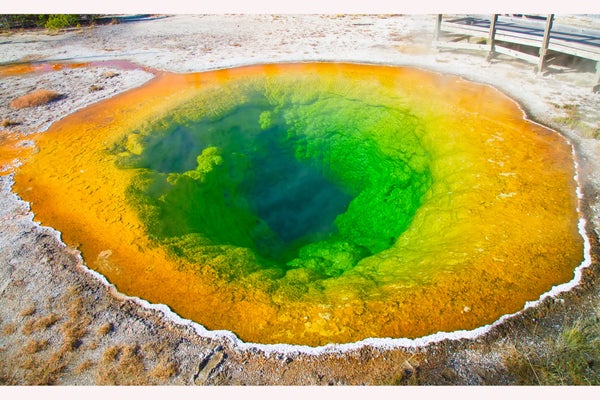Roughly 39 light-years away toward the constellation Aquarius is a planet that hosts a global ocean so deep it drowns the land. Set sail anywhere on that water world and you will never spot mountains, hills or even beaches on the horizon, just deep blue tides. And this planet is not alone. A new analysis of the exoplanets circling TRAPPIST-1—which a 2017 study estimated were all roughly the size, mass and composition of Earth—suggests that four of the seven worlds are actually soaked in water. Two of them are more than 50 percent water, by mass, and the other two are less than 15 percent (that is still far wetter than Earth, which is less than 0.1 percent water). What is more: Multiple lines of evidence suggest that water worlds might be abundant throughout the cosmos.
That might sound like good news. After all, wherever we find water on Earth—be it the acidic pools of Yellowstone or the cracks within frozen glaciers—we find life. The correlation is so strong that NASA has adopted the mantra “follow the water” when searching for life beyond our pale blue dot. But these wet worlds have sparked a lively debate about how much water is too much.
Take the fifth planet within the TRAPPIST-1 system as an example. Cayman Unterborn, an exogeologist at Arizona State University in Tempe, and his colleagues think that the liquid water here extends down about 200 kilometers—roughly 20 times deeper than Earth’s Mariana Trench. That much water would create a large ice layer at the bottom of the ocean which would seal the ocean from the land and effectively shut down a geochemical cycle that plays a crucial role in Earth’s habitability.
On supporting science journalism
If you're enjoying this article, consider supporting our award-winning journalism by subscribing. By purchasing a subscription you are helping to ensure the future of impactful stories about the discoveries and ideas shaping our world today.
On our planet, carbon dioxide can move between the atmosphere and the mantle to keep a temperate climate even when atmospheric conditions change. The sun’s slow increase in luminosity, for example, was counteracted by a decrease in the number of carbon dioxide molecules in the atmosphere as more and more were stored deep within the Earth. This “carbon-silicate cycle” is a balancing act that many scientists argue is crucial for long-term habitability. But on water worlds that cycle may be impossible.
Some scientists, however, are still optimistic for life on these planets—as long as they leave behind their Earth-centric perspective. “A water world isn’t just an Earth that we poured water on, it’s a different planet and there’s no reason to suppose the geology would be identical to ours,” says Elizabeth Tasker, an astronomer at the Japan Aerospace Exploration Agency in Tokyo. Such worlds may have their own ways of regulating temperature.
Two recent studies, for example, suggest that carbon dioxide can still move around on these worlds—albeit in a much different manner and without the ability to travel deep into the planet’s mantle. Ramses Ramirez from the Tokyo Institute of Technology and Amit Levi from the Harvard-Smithsonian Center for Astrophysics, for example, argue that the greenhouse gas can shift back and forth between deep-sea ice and the atmosphere. Another idea, from Edwin Kite from the University of Chicago and Eric Ford from The Pennsylvania State University, is that carbon dioxide can simply shift back and forth between the ocean and the atmosphere. Here, the enormous size of the ocean is actually beneficial because it provides a massive reservoir to hold excess carbon dioxide. In fact, their model suggests that 10 to 25 percent of water worlds can have habitable surface temperatures that persist for more than a billion years—long enough for simple organisms to arise and potentially evolve into complex life.
But worlds awash with so much water present other hurdles for life. That ice layer, for instance, makes it more difficult for organisms to scrape nutrients like phosphorous (the backbone of DNA) from the rock, potentially preventing life from emerging in the first place. “You have a temperate planet and if you and I landed on it, maybe we wouldn’t boil or freeze, and we’d have lots of water—but there just wouldn’t be enough nutrients to actually kick-start life,” Tasker says. And Unterborn agrees that astronomers should set their sights on drier worlds. Yet other scientists think life finds a way. Kite, for example, suggests that nutrients might come from surprising sources such as asteroid impacts. And Levi argues that life could even form in the water that has pooled on the icecaps of these water worlds.
“What I’ve taken away from this project is the inadequacy of working from Earth’s analogy,” says Kite, admitting this conclusion is ironic given that he is a geologist by training. “I love rocks and Earth-history, but you really need to build up from basic physics and chemistry, rather than relying on Earth’s analogy in order to tackle exoplanet problems.” This consideration will be important when astronomers have to determine which individual worlds to further assess with large telescopes like the James Webb Space Telescope or when they have to choose between future missions that would survey hundreds of worlds and those that would study a handful of Earth clones in detail. But there is no consensus yet. “I think it could be dangerous just thinking about everything in an Earth-mindset,” Ramirez says. “You might be missing out on other possibilities.”
